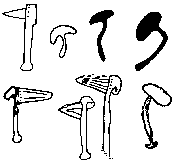the Myth of Race
In his article, entitled Mixed Blood and first published November 1995 in Psychology Today Magazine, Jeffery M Fish examines the cultural foundation of racial ideology and determines that “race is a myth.” Fish designs his argument by first providing an overview of human evolution. He establishes that humans vary physiologically as the result of biological adaptations to regional environments, and that these relative adaptations do not delineate humans into separate races. The American racial terms black and white do not distinguish between separate human species any more than the terms tall or short. Instead, Fish suggests that our understanding of race is culturally arbitrary.
Fish uses the example of a traditional American system of racial classification called hypo-descent, or “blood” descent, to support his argument. In this system, race is determined through an individual’s “blood” history. If an individual has a black parent, grandparent, or other “blood” relative, that individual may be classified as black, despite the color of his or her skin. The cultural ideals of “black blood” and “white blood” do not reflect the physiological reality of human variation. On the contrary, the ideological language of culture often acts as a filter that biases one’s perception of the physical reality.
The Brazilian tipo (“type”) system of classification is another example cited by Fish to support his argument. The tipos are complex descriptive terms that vary regionally. A tipo defines an individual’s race according to the individual’s physical traits, such as light hair, curly hair, dark skin, blue eyes, thick lips, think nose, and any other combination of attributes. Examples are loura (whiter than white, straight blonde hair, blue or green eyes, narrow nose and thin lips), mulata (dark tight curly hair, dark skin, broad nose, thick lips) and branca (light skin color, hair not tightly curled, nose that is not broad, and lips that are not thick). A tipo will describe what a person looks like, but it doesn’t carry the baggage of ancestry. Fish juxtaposes the two examples of cultural race classification by using his daughter as an example of cross-cultural racial ambiguity. Fish’s daughter considers herself black according to American standards of racial classification because her mother is black. However, under the Brazilian system of racial classification, his daughter is not “black” but “morena” because she has dark, wavy hair, tan skin, and a nose and lips that are not narrow.
Fish uses the phrase, “garbage in/garbage out” to crystallize the idea that science shouldn’t depend upon socially defined racial information when developing demographic models. The symbolic language used when classifying an individual will inevitably bias one’s perspective, thus contaminating even the best of scientific intentions. Fish cites the Bell Curve controversy and how subjective racial classifications have led to the misinterpretation of IQ tests and measurements. He states that human beings are a collective species, and that “people from anywhere on the planet can mate with others from anywhere else and produce fertile offspring.” If racial classification had a biological origin, this could not be true.
The idea that race is culturally arbitrary is an important one to recognize, chiefly because, as Fish points out, to engage in a scientific endeavor using racial classification as an objective standpoint is essentially useless. However, humans have a propensity for classifying things, regardless of the symbolic accuracy. Humans depend on those classifications for maintaining perspective and identity. The social myths of racism and social darwinism have precipitated some of history’s most atrocious acts of inhumanity. I agree with Fish’s sentiment that racial classification should be approached with an open mind and a cautious step. Race might be a myth, but people have a knack for believing in myths, often at the expense of some one else’s life.
 the world is what we make it
the world is what we make it
























